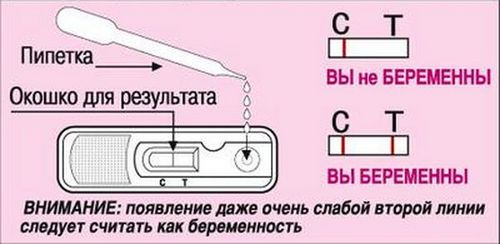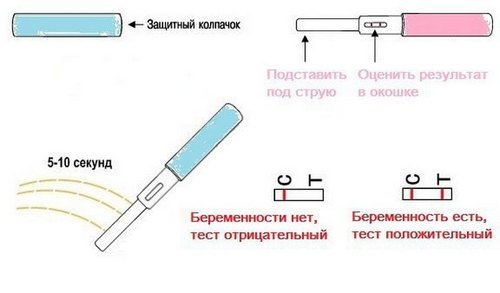A woman’s urine is used to determine pregnancy. With the onset of pregnancy, a special hormone, human chorionic gonadotropin, begins to be produced in the body.
Every day of pregnancy, its concentration in the urine increases and, starting from a certain point, its presence can be determined using a pregnancy test. In any test, there is a reagent that comes into contact with this hormone and signals this to the user.
Women awaiting additions to the family have long mastered the achievement of scientific and technological progress, such as portable pregnancy tests.
Unfortunately, not everyone knows how to use them correctly. In practice, only 75% of the home analysis gives the correct result. Although studies show – if you carefully follow the instructions, the accuracy of the readings is 99%. Thus, in order to get the correct result using a portable pregnancy test, you just need to be able to use it correctly.
There are several types of tests:
- test strips
- tablet
- inkjet
- reusable electronic.
Types of tests, advantages and disadvantages
| test name | advantages of the test | test flaws |
| test strip | low price, ease of use | high probability of making a mistake, low information content, frequent receiving ambiguous results, short time to demonstrate the result |
| tablet test | protection against wet strips, simplicity | high price |
| jet test | the greatest ease of use, the ability to do without dishes, high sensitivity | high price |
| electronic test | high information content, high sensitivity, the ability to connect to a computer | complexity, high price |
Tests have different sensitivity – from 10 units to 30. The smaller the index, the more sensitive the pregnancy test. The most sensitive test systems can detect pregnancy 10 days after ovulation – a few days before low sensitivity tests. As a rule, the more expensive and more difficult the test, the higher its sensitivity. Most test strips have a low sensitivity, but electronic systems have a high sensitivity.
How to use a pregnancy test
When preparing for testing, certain rules must be followed. For testing, it is advisable to use the first morning urine. In it, the concentration of the hormone is greatest. You can not drink plenty of water before collecting urine or take diuretics.
It is also necessary to carefully follow the instructions. If the description indicates that some action needs to be performed for so many seconds, or after so many minutes have passed, then this must be done. Therefore, you need to glance at the clock with a stopwatch from time to time.
Before you start using the pregnancy test, you need to see if it is expired or if the integrity of the package is broken. Most testing devices, except electronic ones with replaceable cartridges, can only be used once.
What is the best day to use a pregnancy test? It is determined based on the menstrual cycle. Some systems are so sensitive that they can recognize fetal development in the last days of the menstrual cycle, that is, 10 days after ovulation. However, most tests are able to give the correct result only in the first days of delayed menstruation.
Application
The methodology for using a pregnancy test largely depends on its type. However, in all cases, it has a lot in common. If in doubt about whether the pregnancy test is used correctly, you need to look into its description.
Test strips
Procedure:
-
- urine is collected in a clean container
the test strip is lowered into the container vertically with the working tip down to the line indicated on the strip (usually it is indicated by the word “Max”),
- the strip is retained in urine the amount of time specified in the description (several seconds, usually about 5),
- the test strip is pulled out of the urine and placed on a horizontal surface,
- after the time specified in the description (several minutes, usually 5, but not more than 10), the result is read.
The test result is valid only for the time specified in the description. After its expiration, the strip loses its information content.
Also, do not overexpose the strip in the urine. The reverse error is also common – insufficient exposure of the strip. All this can distort the test results.
Tablet test
Step-by-step procedure:
- the container supplied with the tablet is filled with urine,
- a droplet of urine is collected in the pipette attached to the tablet,
- the tablet is placed on a horizontal surface,
- a drop of urine drips into a smaller window on the tablet,
- after about 5 minutes (the exact time is indicated in the description), the result is read in another window.
Jet test
Step-by-step procedure:
- the protective cap is removed from the working end of the test module;
- the module with the working end is substituted under a stream of urine for 5-10 seconds (the exact time is indicated in the description). The working end at this moment should be directed downward;
- the module is placed on a horizontal surface;
- after the time specified in the description, the test result is read.
It is necessary to ensure that the stream of urine does not fall on the device itself. In addition, inkjet modules can be used in the same way as test strips, that is, by dipping the working end of the module into a container with urine.
You can use the electronic module in the same way as an inkjet. The only difference is that electronic testing systems are reusable, they use replaceable cartridges.
Indications
The test reading technique is also slightly different for different systems.
On the test strips, two cross lines are used for indication. The appearance of one means that the result is considered valid, the appearance of the second means that the fetus develops.
| first line | second line | value |
| no | no | test is not valid |
| there is | no | no pregnancy |
| no | there is | test is not valid |
| there is | there is | the presence of pregnancy |
The first feature is always clear, but the second, signaling pregnancy, can have different saturations. In some cases, it may be pale or have fuzzy outlines. This should still be counted as a positive result. The reason may be a small amount of hCG in the urine.
In tablet modules, a similar principle is also commonly used. However, dashes are shown in a special window.
The results of the tablet test are decrypted as follows:
- 0 dashes – the test is invalid
- 1 dash – no pregnancy,
- 2 dash – the presence of pregnancy.
In the case of an inkjet test, the results are displayed in the form of pluses and minuses (plus – a positive result, minus – no pregnancy), or transverse lines.
In electronic devices, the words “pregnant” / “not pregnant” may appear (woman is pregnant / not pregnant). In the most advanced systems, not only the test result is shown, but also, in the case of pregnancy, how many weeks the development of the fetus lasts. For example, the inscription “1-2” means 1-2 weeks, “2-3” – 2-3 weeks, “3+” – more than 3 weeks.
The readings of the electronic test can be stored for a long time in the device’s memory.
Photo of the step-by-step process
The figures below show how to test with a test strip, tablet and inkjet module.
Test strip

Photo: Test Strip
Tablet test

Photo: Tablet Test
Jet test

Photo: Inkjet Test



